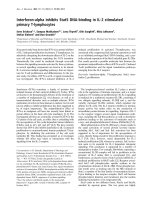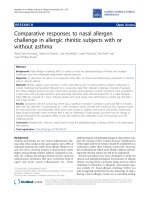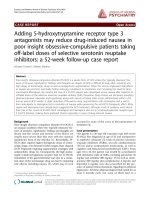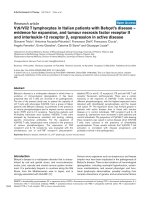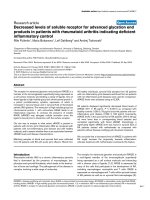Báo cáo y học: "IL-4 alpha chain receptor (IL-4Rα) polymorphisms in allergic bronchopulmonary sspergillosis" pps
Bạn đang xem bản rút gọn của tài liệu. Xem và tải ngay bản đầy đủ của tài liệu tại đây (264.88 KB, 6 trang )
BioMed Central
Page 1 of 6
(page number not for citation purposes)
Clinical and Molecular Allergy
Open Access
Research
IL-4 alpha chain receptor (IL-4Rα) polymorphisms in allergic
bronchopulmonary sspergillosis
Alan P Knutsen*
1,3
, Barbara Kariuki
1
, Judy D Consolino
2
and
Manoj R Warrier
1
Address:
1
Division of Allergy/Immunology, Saint Louis University Health Sciences Center and St. Louis, Missouri, USA,
2
Division of Pulomology,
Saint Louis University Health Sciences Center, St. Louis, Missouri, USA and
3
Professor Pediatrics, Director Allergy & Immunology, Pediatric
Research Institute, 3662 Park Avenue, St. Louis, MO 63110, USA
Email: Alan P Knutsen* - ; Barbara Kariuki - ; Judy D Consolino - ;
Manoj R Warrier -
* Corresponding author
Abstract
Background: Allergic bronchopulmonary aspergillosis occurs in 7–10% of cystic fibrosis (CF) and
1–2% of asthmatic patients. HLA-DR restriction and increased sensitivity to IL-4 stimulation have
been proposed as risk factors in these populations.
Objective: We examined for the presence of IL-4 receptor alpha chain (IL-4Rα) single nucleotide
polymorphisms (SNPs) in ABPA and whether these accounted for increased sensitivity to IL-4
stimulation.
Methods: One extracellular (ile75val) and four cytoplasmic IL-4Rα SNPs were analyzed in 40 CF
and 22 asthmatic patients and in 56 non-ABPA CF and asthmatic patients. Sensitivity to IL-4
stimulation was measured by induction of CD23 expression on B cells.
Results: IL-4Rα SNPs were observed in 95% of ABPA patients. The predominant IL-4Rα SNP was
the extracellular IL-4Rα SNP, ile75val, observed in 80% of ABPA patients.
Conclusion: The presence of IL-4Rα SNPs, principally ile75val, appears to be a genetic risk for the
development of ABPA.
Background
Allergic bronchopulmonary aspergillosis (ABPA) is a Th2
cell mediated hypersensitivity lung disease due to bron-
chial colonization with A. fumigatus that affects approxi-
mately 1–2% of asthmatic and 7–9% of cystic fibrosis
(CF) patients [1,2]. The immunologic hallmarks of ABPA
are elevated IgE antibodies to A. fumigatus, elevated total
serum IgE levels, and peripheral blood and bronchial
eosinophilia. A sequelae of ABPA is bronchiectasis and/or
pulmonary fibrosis which progressively compromises res-
piratory function increasing morbidity and mortality.
Sensitization to A. fumigatus is common in asthmatic and
CF patients, yet only a small percentage develop ABPA.
We hypothesize that ABPA patients have genetic risk fac-
tors which predispose for the development of ABPA.
Chauhan et al [3-5] found that ABPA patients have
increased frequency of HLA-DR2 and DR5. However, only
a minority of atopic patients with these genotypes develop
ABPA.
Published: 17 February 2006
Clinical and Molecular Allergy 2006, 4:3 doi:10.1186/1476-7961-4-3
Received: 21 October 2005
Accepted: 17 February 2006
This article is available from: />© 2006 Knutsen et al; licensee BioMed Central Ltd.
This is an Open Access article distributed under the terms of the Creative Commons Attribution License ( />),
which permits unrestricted use, distribution, and reproduction in any medium, provided the original work is properly cited.
Clinical and Molecular Allergy 2006, 4:3 />Page 2 of 6
(page number not for citation purposes)
In earlier studies, we reported that ABPA patients demon-
strated increased sensitivity to IL-4 stimulation as meas-
ured by up-regulation of CD23 on their B-cells [6,7].
Previous studies have reported that single nucleotide pol-
ymorphisms (SNP) of the IL-4 alpha receptor (IL-4Rα) is
associated with up-regulation of IL-4 stimulation [8-16].
In this study to explain this observation of increased sen-
sitivity to IL-4 stimulation, we examined IL-4 receptor
alpha chain (IL-4Rα) single nucleotide polymorphisms
(SNP). The frequency of IL-4Rα SNPs was present in
approximately 95% of ABPA patients, and the predomi-
nant SNP was ile75val in the IL-4 binding region. We pro-
pose that increased sensitivity to IL-4 in conjunction with
HLA-DR2/DR5 restriction to Aspergillus antigens in ABPA
patients result in increased B-cell activity, monocyte/den-
dritic cell phenotype that polarizes Aspergillus-specific Th2
responses.
Methods
Patients
The study population consisted of 40 CF and asthmatic
ABPA patients and 56 non-ABPA CF and asthmatic con-
trol patients. The study was approved by the Saint Louis
University Institutional Review Board. Criteria for ABPA
in asthmatic patients are those described previously by
Greenberger [1]. Recently, a Cystic Fibrosis Foundation
Consensus Conference proposed diagnostic criteria for
the diagnosis of ABPA in CF patients that was used for this
study [2]:
1. Clinical deterioration (cough, wheeze, exercise intoler-
ance, exercise induced asthma, deterioration of pulmo-
nary function, increased sputum).
2. Serum IgE level ≥500 IU/ml.
3. IgE anti-Aspergillus antibody. Either immediate cutane-
ous reactivity to Aspergillus or presence of IgE anti-Af anti-
bodies by ELISA.
4. IgG anti-Aspergillus antibody. Either precipitating anti-
bodies to Aspergillus or presence of IgG anti-Af antibodies
by ELISA.
5. Abnormal chest radiograph and/or high-resolution
computerized tomography (infiltrates, bronchiectasis,
plugging, or change from previous radiograph), as read by
the radiologist.
IL-4R
α
genotyping by PCR with sequence-specific primers
and direct sequence analysis
Genomic variants in IL-4Rα gene was identified by direct
sequencing using PCR-based method for single nucle-
otide polymorphism (SNP). Genomic variants of IL-4Rα
were numbered on the basis of their location in IL-4Rα
mRNA sequence of gene bank accession number X52425.
Five previously reported IL-4Rα variants ile75val,
glu400ala, cys431arg, ser503pro and gln576arg (number-
ing including the 25 amino acid signal peptide) were gen-
otyped. Presence of polymorphisms and its allelic variants
were determined by direct PCR-SSP protocols with slight
modifications [17].
Genotyping for the ile75val SNP of the IL-4Rα gene was
determined by PCR amplification. A 755 bp long region
of IL-4Rα was amplified using the following primers: for-
ward 5' ATGCAGAGCTTATGTTGTTCTA3' and reverse 5'
TTCCTCCTGCTGTTGCTATGA3'. PCR reactions for iden-
tification of IL-4Rα variants glu400ala, cys431arg,
ser503leu and gln576arg were conducted by amplifying a
991 bp long fragment using the following primers: for-
ward 5' CTGTTTTCTGGAGCACAACAT 3' and reverse 5'
CTTGAGAAGGCCTTGTAACCA 3'. Allele specific primers
were used to amplify specific regions of IL-4 receptors con-
taining the alleles of interest using a thermal cycler (Per-
kin Elmer Model 9700, Cetus, Norwalk, CT) and
polymerase (AmpliTaq Gold, Perkin Elmer) as previously
described by Bux et al [18]. Thermal cycling conditions for
first PCR amplification of genomic fragments was as fol-
lows: Each DNA sample was subjected to 40 cycles of
denaturation at 95°C for 45 s, annealed at 60°C for 45 s
and extension at 72°C for 90 s. PCR products were visual-
ized on 1% agarose gel with ethidium bromide. A second
PCR was performed for direct sequencing of amplified
fragments using the Big Dye Terminator Kit (Perkin-Elmer
Applied Biosystems, Foster City, CA) and subsequent
analysis on a capillary automated sequencer CEQ 2000XL
(Beckman Coulter, Fullerton, CA). The presence of IL-4Rα
nucleotide polymorphisms were examined using the
NCBI Blast program ( />bl2seq/wblast2; accession number 33833); homozygous/
heterozygous SNPs were detected on the nucleotide chro-
matograph.
Table 1: Demographics of asthmatic and cystic fibrosis patients
with allergic bronchopulmonary aspergillosis (ABPA).
Study ABPA (40) Non-ABPA (56)
CF 14 (35%) 33 (59%)
Asthma 26 (65%) 23 (41%)
Age, yrs 24 ± 18 27 ± 12
Sex, % male 65% 64%
IgE, IU/ml 2617 ± 2275 87 ± 133
Reactivity to A. fumigatus
Positive Af skin test 40 (100%) 23 (41%)
IgG anti-Af antibody 40 (100%) 49 (88%)
Abbreviations: ABPA, allergic bronchopulmonary aspergillosis; CF,
cystic fibrosis; Af, Aspergillus fumigatus.
Data presented as number of patients and in parentheses percentage.
For age and IgE, data presented as Mean ± SD.
Clinical and Molecular Allergy 2006, 4:3 />Page 3 of 6
(page number not for citation purposes)
IL-4 induction of B-cell CD23 expression
Peripheral blood mononuclear cells (PBMC) were iso-
lated from venous blood by Ficoll-Hypaque density cen-
trifugation as previously described [6,7]. PBMC were
cultured at 1 × 10
6
cells/ml in 1 ml of RPMI 1640 supple-
mented with 10% FCS for 48 hours at 37°C in a 6% CO
2
humidified atmosphere. The cultures were stimulated
with rhuIL-4 (PeproTech, Inc) at 1, 5, 10 and 25 ng/ml.
After 48 hours, the cells were washed and analyzed by
flow cytometry.
Flow cytometry
PBMC prior to culture and after culture were analyzed for
induction of cell surface CD23 expression on B-cells, and
T-cells analyzed for induction of cytoplasmic cytokine
expression as previously described [7]. For cultures stimu-
lated with IL-4 and IL-13, PBMC were washed and stained
with murine monoclonal antibody to CD23-PE and
CD20 Per-CP (Becton Dickinson). PBMCs were washed
and fixed with 1% PBS buffered paraformaldehyde. For-
ward and side-scatter was performed to gate on the live
lymphocyte population and further gated on CD20
+
cells
for analysis using the CellQuest MacIntosh program (Bec-
ton Dickinson). A minimum of 10,000 cells were
counted. Quantibrite PE flow cytometry beads (Becton
Dickinson) were used to quantitate the number of CD23
receptors per B-cell for each experiment. The beads con-
tain a given number of PE molecules per bead. A linear
equation was calculated from which the number of CD23
receptors per cell was extrapolated, and the total number
of CD23 receptors expressed per B-cell expressed.
Statistics
Analysis of the frequency of IL-4Rα SNPs was analyzed by
chi square analysis and used to compare ABPA versus the
non-ABPA patients. CD23 expression was analyzed by
Student's t-test with unequal variance. Based on the pub-
lished data, we estimate that there will need to be 30
patients in each group to have a 95% power to detect a
mean difference of 9.48%, statistically significant with P
value (alpha) = .05 (two-tailed), using GraphPad StatMate
software package.
Results
Patients
The demographic characteristics of the patients are pre-
sented in Table 1. There were 14 CF and 26 asthmatic
ABPA patients; there were 33 CF and 23 asthmatic non-
ABPA patients. The sex distribution was equal in the asth-
matic and CF ABPA patients compared to the non-ABPA
patients, 65% versus 64%. The demongraphic of the asth-
matic and CF ABPA patients was comparable except that
asthmatic ABPA patients were older than CF ABPA
patients, 41 versus 12 years old, and this also observed for
the non-ABPA patients. IgE reactivity to A. fumigatus was
identified in 100% of ABPA patients and in 41% of non-
ABPA patients; IgG reactivity was determined by ELISA
assay and was identified in 100% of ABPA and 88% of
non-ABPA patients. Serum IgE levels were markedly ele-
vated in ABPA patients compared to non-ABPA patients,
2617 ± 2275 versus 87 ± 133 IU/ml (P < 0.01).
Table 2: IL-4Rα single nucleotide polymorphisms in asthmatic and cystic fibrosis patients with allergic bronchopulmonary aspergillosis
(ABPA).
Study Number of Patients P*
ABPA (40) Non-ABPA (56)
Extracellular IL-4Rα SNPs
ile75val 32 (80%) 30 (54%) 0.008
asn98thr 2 (5%) 4 (8%) ns
Homozygous ile75val 17 (43%) 6 (11%) 0.0003
Cytoplasmic IL-4Rα SNPs
glu400ala 5 (13%) 3 (5%) ns
cys431arg 3 (8%) 4 (7%) ns
ser503pro 9 (23%) 10 (18%) ns
gln576arg 8 (20%) 14 (25%) ns
Any IL-4Rα SNP 38 (95%) 34 (61%) 0.0001
Extracellular and Cytoplasmic IL-
4Rα SNP
11 (28%) 12 (21%) ns
Abbreviations: IL-4Rα, interleukin 4 receptor alpha chain; SNP, single nucleotide polymorphism; ABPA, allergic bronchopulmonary aspergillosis; ns,
not significant.
In parentheses, percentage (%) of patients.
* Chi square analysis comparing ABPA versus Non-ABPA patients.
Clinical and Molecular Allergy 2006, 4:3 />Page 4 of 6
(page number not for citation purposes)
IL-4Ra SNPs
The frequency of IL-4 Rα SNPs was significantly increased
in ABPA patients compared to non-ABPA patients, 95%
versus 61% (p = 0.0001) (Table 2). The predominant IL-
4Rα SNP observed was ile75val in IL-4 binding region.
This was observed in 80% of ABPA patients compared to
54% of non-ABPA patients (p = 0.008). The frequencies of
IL-4Rα SNPs were comparable comparing asthmatic and
CF ABPA patients: IL-4Rα SNPs 93% and 96% and
ile75val 79% and 81%, respectively. Furthermore, the
ile75val SNP was homozygous in 43% of ABPA patients
compared to 11% of non-ABPA patients (p = 0.0003). An
additional extracellular SNP, asn98thr, was identified in a
CF ABPA patient as an isolated polymorphism. We previ-
ously reported this patient, and this was associated with
increased sensitivity to IL-4 stimulation [19]. One or more
cytoplasmic IL-4Rα SNPs were observed in 38% of ABPA
patients compared to 27% of non-ABPA patients (p = ns).
The combination of ile75val and cytoplasmic SNPs were
not significantly increased in ABPA patients compared to
non-ABPA patients, present in 28% and 21%, respec-
tively.
Up-regulation of CD23 by IL-4 stimulation
The up-regulation of CD23 molecules on B-cells by IL-4
stimulation is shown in Figure 1. In the absence of IL-4,
the number of CD23 molecules decreased after 48 hours
in media and was comparable in both groups. With IL-4
stimulation, the slope of increased number of CD23 mol-
ecules per B-cell was significantly greater in ABPA patients
compared to non-ABPA patients (p < 0.01). Furthermore,
the number of CD23 molecules per B-cell was increased in
ABPA patients at IL-4 concentrations of 1 ng/ml, 5 ng/ml
and 10 ng/ml. Up-regulation of CD23 expression was
observed for each of the IL-4Rα SNPs.
Discussion
A key question in the development of ABPA in CF and
asthmatic patients is why do only 1–2% and 7–9% of this
at risk population develop ABPA. Chauhan et al [3-5]
observed that patients with asthma and CF who expressed
HLA-DR2 and/or DR5 (and perhaps HLA-DR4 or DR7)
but lacked HLA-DQ2 were at increased risk for ABPA after
exposure to A. fumigatus. Within HLA-DR2 and HLA-DR5,
restricted genotypes, in particular, HLA-DR2 B1*1501
and 1503 and HLA-DR5 B1*1101 and B1*1103, provide
high relative risk. On the other hand, 40% to 44% of non-
ABPA atopic Aspergillus-sensitive individuals have the
HLA-DR2 and/or DR5 type. These results demonstrating
HLA-DR restriction are similar to those found with puri-
fied house dust mite allergens [20-22]. Thus, certain gen-
otypes of HLA-DR2 and DR5 may be necessary but not
sufficient to cause ABPA. Furthermore, Chauhan et al [4]
demonstrated that Asp f l allergen has a low-affinity of
binding to HLA-DR. This is consistent with Th2 T cell
response previously reported by others in that strong anti-
gen HLA-DR-Ag-TCR affinity binding favored a Th1 cellu-
lar response whereas low affinity binding favored a Th2
humoral response [21-25]. Thus, we propose that antigen
presenting cells bearing HLA-DR2/DR5 and with
increased sensitivity to IL-4 stimulation may play a critical
role in skewing the Th2 responses to A. fumigatus in ABPA.
We previously reported that in ABPA patients there was
significant up-regulation of CD23 expression of IL-4 stim-
ulated peripheral blood mononuclear cells [7]. Other
investigators have identified IL-4Rα single nucleotide pol-
ymorphisms (SNP) that result in a gain-of-function of IL-
4 stimulation [8-16]. We examined one extracellular and
four cytoplasmic SNPs. In these studies, we observed IL-
4Rα SNPs in 95% of ABPA patients. The extracellular IL-4
binding SNP, ile75val, was the most frequently identified
SNP and was frequently homozygous. Hershey's group
reported that the combination of two variants, ile75val
and gln576arg, together resulted in elevated IL-4 depend-
ent CD23 expression and risk of atopy and asthma sever-
ity which was not observed when these SNPs were present
alone [16]. However, we observed the combination of
ile75val and a cytoplasmic IL-4Rα SNP in only 28% of
ABPA patients.
Other genetic risk factors have been proposed for the
development of atopy, asthma and ABPA. In particular, in
the development of increased asthma severity, investiga-
tors have reported that another combination of the
ile75val IL-4Rα SNP and arg110gln IL-13 SNP has also
been associated with allergy and asthma [26,27]. We have
recently begum studies to examine the IL-13 SNP. Saxena
IL-4 induction of CD23+ molecules on CD20+B-cellsFigure 1
IL-4 induction of CD23+ molecules on CD20+B-cells. Following
IL-4 stimulation, ABPA patients had a significantly increased
rate of CD23+ expression per B-cell compared to non-ABPA
patients at 5 ng/ml and 10 ng/ml (p < 0.02*, < 0.02*). Data
presented as Mean ± SE.
0
2000
4000
6000
8000
10000
12000
14000
-1012345678910
IL-4, ng/ml
CD23+ Molecules
ABPA (36) Non-ABPA (51)
*
*
Clinical and Molecular Allergy 2006, 4:3 />Page 5 of 6
(page number not for citation purposes)
et al [28] reported that ABPA patients with polymor-
phisms (ala91pro, arg94arg) in the collagen region of pul-
monary surfactant protein A2 (SP-A2) had more elevated
total IgE levels and higher percentages of eosinophilia
than those observed in patients who lacked the SNPs.
They also found that 80% of patients carrying both alleles
had ABPA (P = 0.0079, OR = 10.4), while only 50% and
60% of patients carrying each allele, individually, were
ABPA subjects, suggesting an additive effect.
IL-10 may also play a significant role in the development
of atopy and ABPA. In previous studies, we observed
increased IL-10 and IL-5 synthesis of Asp f2, f3 and f4
stimulated peripheral blood lymphocytes in CF and asth-
matic ABPA patients [7]. Polymorphisms of the IL-10 pro-
moter have been associated with risk of asthma [29] and
ABPA [30]. In particular, Brourad et al [30] reported the
association of the -1082GG genotype of IL-10 promoter
and the colonization with A. fumigatus and the develop-
ment of ABPA in CF. The -10822G polymorphism has
been associated with increased IL-10 synthesis; whereas
the -1082A allele has lower IL-10 synthesis. These investi-
gators reported that 23–25% of CF patients were -
1082GG, 49–53% -1082AG, and 24–26% -1082AA.
There was significantly increased risk to become colo-
nized with A. fumigatus and to develop ABPA in the -
1082GG genotype group, which developed in 7% of the
patients. Thus, one may hypothesize that antigen present-
ing cells (dendritic cells) expressing HLA-DR2/DR5 with
increased IL-10 synthesis and increased sensitivity to IL-4
stimulation due to IL-4Rα polymorphisms may be
responsible for driving an allergic inflammatory response
to A. fumigatus in ABPA.
The major limitation of this study is the small numbers of
ABPA patients studied. However, the frequency of IL-4Rα
polymorphisms is so prevalent, further studies will likely
confirm this preliminary study.
Competing interests
The author(s) declare that they have no competing inter-
ests.
Authors' contributions
APK conceived of the study, participated in its design and
coordination, and drafted the manuscript; BK participated
in the molecular genetic studies; JDC was instrumental in
providing patient samples; and MRW participated in the
molecular genetic studies. All authors read and approved
of the final manuscript.
Acknowledgements
The authors appreciate the willing participation of the patients who partic-
ipated in this study. The study was funded by grants from the Cystic Fibrosis
Foundation.
References
1. Greenberger PA: Allergic bronchopulmonary aspergillosis. In
Allergy: Principles and Practice Edited by: Adkinson NF Jr, Yunginer JW,
Busse WW, Bochner BS, Holgate ST, Simons FER. Mosby, St. Louis;
2003:1353-1371.
2. Stevens DA, Moss R, Kurup VP, Knutsen AP, Greenberger P, Judson
MA, Denning DW, Crameri R, Brody A, Light M, Skov M, Maish W,
Mastella G, the Cystic Fibrosis Foundation Consensus Conference:
Allergic bronchopulmonary aspergillosis in cystic fibrosis:
Cystic Fibrosis Foundation Consensus Conference. Clin Infect
Dis 2003, 37:S225-S264.
3. Chauhan B, Santiago L, Hutcheson PS, Schwartz HJ, Spitznagel E, Cas-
tro M, Slavin RG, Bellone CJ: Evidence for the involvement of
two different MHC class II regions in susceptibility or protec-
tion in allergic bronchopulmonary aspergillosis. J Allergy Clin
Immunol 2000, 106:723-729.
4. Chauhan B, Santiago L, Kirschmann DA, Hauptfeld V, Knutsen AP,
Hutcheson PS, Woulfe SL, Slavin RG, Schwartz HJ, Bellone CJ: The
association of HLA-DR alleles and T cell activation with
allergic bronchopulmonary aspergillosis. J Immunol 1997,
159:4072-4076.
5. Chauhan BA, Knutsen AP, Hutcheson PS, Slavin RG, Bellone CJ: T
cell subsets, epitope mapping, and HLA-restriction in
patients with allergic bronchopulmonary aspergillosis. J Clin
Invest 1996, 97:2324-2331.
6. Khan SP, McClellan JS, Knutsen AP: Increased sensitivity to IL-4
in patients with allergic bronchopulmonary aspergillosis and
atopy. Inter Arch Allergy Immunol 2000, 123:319-326.
7. Knutsen AP, Hutcheson PS, Albers GM, Consolino J, Smick J, Kurup
VP: Increased sensitivity to IL-4 in cystic fibrosis patients with
allergic bronchopulmonary aspergillosis. Allergy 2004,
58:81-88.
8. Hershey GKK, Friedrich MF, Esswein LA, Thomas ML, Chatila TA:
Association of atopy with a gain-of-function mutation in the
interleukin-4 receptor a chain. N Engl J Med 1997,
337:1720-1725.
9. Mitsuyasu H, Izuhara K, Mao XQ, Gao PS, Arinobu Y, Enomoto T,
Kawai M, Sasaki S, Dake Y, Hamasaki N, Shirakawa T, Hopkin JM:
Ile50Val variant of IL4R alpha upregulates IgE synthesis and
associates with atopic asthma. Nat Genet 1998, 19:119-120.
10. Deichmann K, Bardutsky J, Forster J, Heinzmann A, Kuehr J: Com-
mon polymorphisms in the coding part of the IL-4 receptor
gene. Biochim Biophys Acta 1997, 231:696-697.
11. Kruse S, Japha T, Tedner M, Sparholt SH, Forster J, Kuehr J, Deich-
mann KA: The polymorphisms S503P and Q576R in the inter-
leukin-4 receptor alpha gene are associated with atopy and
influence the signal transduction. Immunology 1999, 96:265-271.
12. Ober C, Leavitt SA, Tsalenko A, Howard TD, Hoki DM, Daniel R,
Newman DL, Wu X, Parry R, Lester LA, Solway J, Blumenthal M, King
RA, Xu J, Meyers DA, Bleecker ER, Cox NJ: Variation in the inter-
leukin-4 receptor alpha gene confers susceptibility to asthma
and atopy in ethnically diverse populations. Am J Hum Genet
2000, 66:517-526.
13. Wjst M, Kruse S, Illig T, Deichmann K: Asthma and IL-4 receptor
alpha gene variants. Eur J Immunogenetics 2002, 29:263-268.
14. Rosa-Rosa L, Zimmermann N, Bernstein JA, Rothenberg ME, Khurana
Hershey GK: The R576 IL-4 receptor alpha allele correlates
with asthma severity. J Allergy Clin Immunol 1999, 104:1008-1014.
15. Mitsuyasu H, Yanagihara Y, Mao X, Gao P, Arinobu Y, Ihara K,
Takabayashi A, Hara T, Enomoto T, Sasaki S, Kawai M, Hamasaki N,
Shirakawa T, Hopkin JM, Izuhara K: Cutting edge: Dominant
effect of Ile50Val variant of the human IL-4 receptor α-chain
in IgE synthesis. J Immunol 1999, 162:1227-1231.
16. Risma KA, Wang N, Andrews RP, Cunningham CM, Ericksen MB,
Bernstein JA, Chakraborty R, Hershey GK: V75R576 IL-4 receptor
alpha is associated with allergic asthma and enhanced IL-4
receptor function. J Immunol 2002, 169:1604-1610.
17. Hackstein H, Kluter H, Fricke L, Hoyer J, Bein G: The IL-4 receptor
alpha-chain variant Q576R is strongly associated with
decreased kidney allograft survival. Tissue Antigens 1999,
54:471-477.
18. Bux J, Stein EL, Bierling P, Fromont P, Clay M, Stroncel D, Santoso S:
Characterization of a new alloantigen (SH) on the human
neutrophil Fc gamma receptor IIIb. Blood 1997, 89:1027-1034.
19. Knutsen AP, Warrier MR, Noyes B, Consolino J: Allergic bron-
chopulmonary aspergillosis in a patient with cystic fibrosis:
Publish with BioMed Central and every
scientist can read your work free of charge
"BioMed Central will be the most significant development for
disseminating the results of biomedical research in our lifetime."
Sir Paul Nurse, Cancer Research UK
Your research papers will be:
available free of charge to the entire biomedical community
peer reviewed and published immediately upon acceptance
cited in PubMed and archived on PubMed Central
yours — you keep the copyright
Submit your manuscript here:
/>BioMedcentral
Clinical and Molecular Allergy 2006, 4:3 />Page 6 of 6
(page number not for citation purposes)
diagnostic criteria when the IgE level is <500 IU/ml. Ann
Allergy Asthma Immunol 2005 in press.
20. Verhoef A, Higgins JA, Thorpe CJ, Marsh SG, Hayball JD, Lamb JR,
O'Hehir RE: Clonal analysis of the atopic immune response to
the group 2 allergen of Dermatophagoides spp.: identifica-
tion of HLA-DR and -DQ restricted T cell epitopes. Inter
Immunol 1993, 5:1589-1597.
21. Lamb JR, Higgins JA, Hetzel C, Hayball JD, Lake RA, O'Hehir RE: The
effects of changes at peptide residues contacting MHC class
II T-cell receptor on antigen recognition and human Th0 cell
effector function. Immunol 1995, 85:447-454.
22. Tsitoura DC, Verhoef A, Gelder CM, O'Hehir RE, Lamb JR: Altered
T cell ligands derived from a major house dust mite allergen
enhance IFN-γ but not IL-4 production by human CD4
+
T
cells. J Immunol 1996, 157:2160-2165.
23. Pfeiffer C, Stein J, Southwood S, Ketelaar H, Sette A, Bottomly K:
Altered peptide ligands can control CD4 T lymphocyte dif-
ferentiation in vivo. J Exp Med 1995, 181:1569-1574.
24. Evavold BD, Sloan-Lancaster J, Hsu BL, Allen PM: Separation of T
helper 1 clone cytolysis from proliferation and lymphokine
production using analog peptides. J Immunol 1993,
150:3131-3140.
25. Racioppi L, Ronchese F, Matis LA, Germain RN: Peptide-major his-
tocompatibility complex class II complexes with agonist/
antagonist properties provide evidence for ligand related dif-
ferences in T cell receptor dependent intracellular signaling.
J Exp Med 1993, 177:1047-1060.
26. Chen W, Ericksen MB, Hershey GKK: Functional effect of the
R110Q IL13 genetic variant alone and in combination with
IL4RA genetic variants. J Allergy Clin Immuno 2004, 114:553-560.
27. Vladich FD, Brazille SM, Stern D, Peck ML, Ghittoni R, Vercelli D: IL-
13 R130Q, a common variant associated with allergy and
asthma, enhances effector mechanisms essential for human
allergic inflammation. J Clin Invest 2005, 115:747-754.
28. Saxena S, Madan T, Shah A, Muralidhar K, Sarma PA: Association of
polymorphisms in the collagen region of SP-A2 with
increased levels of total IgE antibodies and eosinophilia in
patients with allergic bronchopulmonary aspergillosis. J
Allergy Clin Immunol 2003, 111:1001-1007.
29. Karjalainen J, Hulkkonen J, Nieminen MM, Huhtala H, Aromaa A,
Klaukka T, Hurme M: Interleukin-10 gene promoter region pol-
ymorphism is associated with eosinophil count and circulat-
ing immunoglobulin E in adult asthma. Clin Exp Allergy 2003,
33:78-83.
30. Brouard J, Knauer N, Boelle P-Y, Corvol H, Henrion-Caude A, Fla-
mant C, Bremont F, Delaisi B, Duhamel J-F, Marguet C, Roussey M,
Miesch M-C, Chadelat K, Boule M, Fauroux B, Ratjen F, Grasemann
H, Clement A: Influence of interleukin-10 on airways coloniza-
tion by Aspergillus fumigatus in cystic fibrosis patients. J
Infect Dis 2005, 191:1988-1991.


